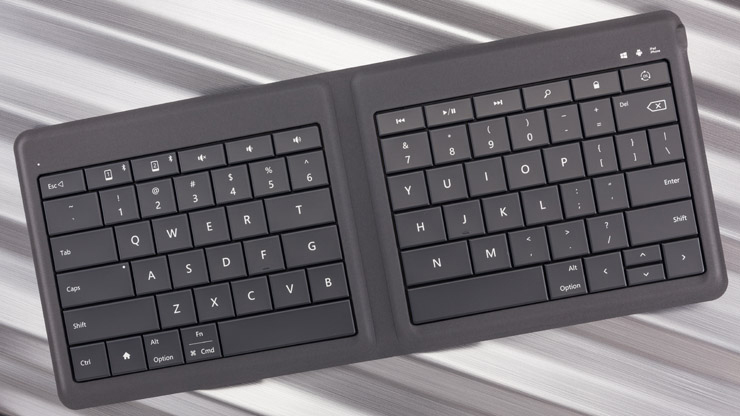
[ad_1]
The Microsoft Universal Foldable Keyboard is going to create some divided opinions. There will be split decisions. There might even be a gulf between people who like it and people who don’t. And that gulf runs right down the middle of this handsome portable keyboard. The most dominant feature of Microsoft’s new $99.95 Bluetooth 4.0 keyboard is the inch-wide moat between its left and right sides. So although it’s light, thin, and nicely built, the design pretty much restricts the keyboard to touch typists who keep their hands from roaming past the median line.
Design and Performance
Listen: I understand that split keyboards are a thing. They’ve been a thing for years. But by and large, they’re designed to make typing more comfortable by letting you angle your wrists while typing, as on the Editor’s Choice Microsoft Sculpt Ergonomic Desktop ($89.69 at Amazon)(Opens in a new window) . The Universal Foldable Keyboard is split, but straight, so it isn’t ergonomic.
The keyboard is made of a gray soft-touch material on the outside and around the edges. The keys are black plastic, with a noticeable soft-touch bezel. It measures 11.6 by 4.9 by 0.2 inches (HWD) and 7.1 ounces open, and it folds to 5.7 by 5.0 by 0.4 inches (HWD). It’s a little too deep to fit into a jacket or pants pocket, but it’ll disappear easily into a bag.
The keyboard charges via micro USB, and Microsoft says it gets up to three months of battery life on a single charge. It turns on automatically when you open it. Pairing is pretty simple—hold down one of the two function keys used to switch devices, wait for it to light up, and pair. An OS Switch key in the upper right corner flips the function keys between Windows, Android, and iOS modes. That impacts the home, search, volume, media control, and function keys, and it worked as advertised.
Similar Products
I hooked the keyboard up to a Samsung Galaxy S6 ($129.71 at Amazon)(Opens in a new window) , an HTC One M8 for Windows , and an Apple iPhone 6 Plus ($299.00 at Verizon)(Opens in a new window) . It paired with all three phones, and typing was lively and quick, with no visible delays in several different applications. The function keys worked on all three platforms, although I’m a little perplexed by Microsoft deciding to use real estate for Alt and Cmd keys in a mobile context—those keys are used much more on desktop systems. This certainly isn’t a desktop keyboard, as it has no numbered F keys and no trackpad option.

The size of the 76 keys, in general, is great—this is a full-sized keyboard. It’s quirky, though. The T, G, 7, H, and N keys are larger than the others. Those larger keys, which abut the gulf, helped my non-touch-typing self not fall over the edge, but it may throw off typists used to same-size keys. Putting that gutter down the middle and expanding some of the letter keys, meanwhile, means the lesser-used punctuation keys get short shrift. Many of the punctuation keys are half-width.
As I used the keyboard primarily with smartphones, I encountered another ergonomic issue: As there’s no stand element, your phone is likely to lay flat on the table, which is very ergonomically inappropriate.
On the plus side, the keys have a good tactile feel and are lovely to type on. They’re chiclet keys with scissor switches, similar to laptop keys but a bit shallower. The letters are printed on the keys rather than etched, which means they’ll eventually wear off, but a keyboard like this isn’t for everyday use.
Conclusions
The Microsoft Universal Foldable Keyboard is slim, light, and has long battery life. But the split nature makes it difficult to type on for many people, it lacks a touchpad element for Windows tablets, and it doesn’t offer a way to prop up your portable device. For tablets, we recommend a dedicated keyboard case like the Editor’s Choice Belkin Qode Ultimate Pro ($39.99 at Amazon)(Opens in a new window) for the iPad, or the Type Cover ($124.68 at Amazon)(Opens in a new window) for the Surface 3. For phones, the Logitech K480 ($34.99 at Amazon)(Opens in a new window) is much less expensive and props up your phone, but it’s not as portable.
3.0

(Opens in a new window)
(Opens in a new window)
The Microsoft Universal Foldable Keyboard is attractive and extremely portable, but a large split down the middle could make it difficult for some to use.
[ad_2]
Source link : https://www.pcmag.com/reviews/microsoft-universal-foldable-keyboard



